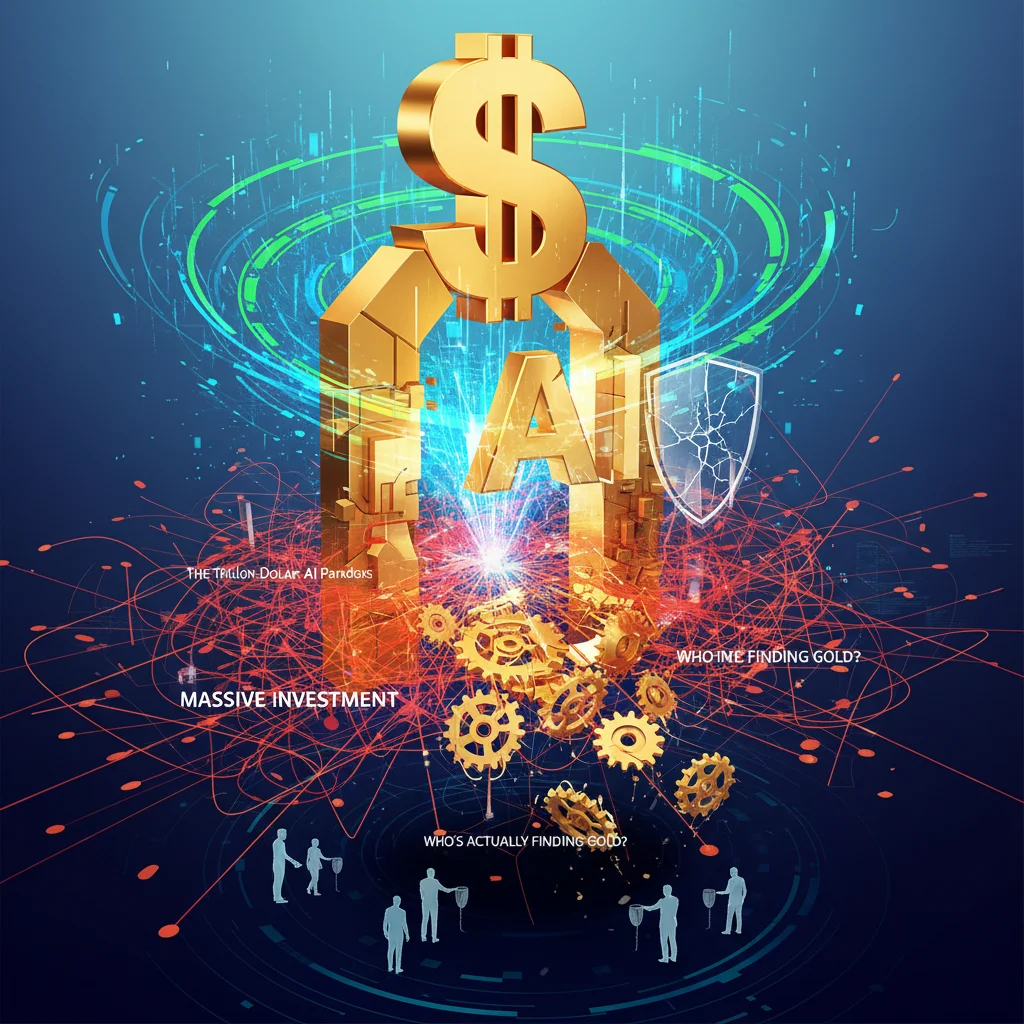
The Trillion-Dollar AI Paradox: Why Massive Investment Isn’t Guaranteeing Success
The AI Gold Rush Is Here, But Who’s Actually Finding Gold?
We are living through a tectonic shift in the global economy, a moment fueled by silicon and syntax. Businesses across every sector are pouring staggering sums into Artificial Intelligence, with corporate spending projected to reach hundreds of billions of dollars annually. This capital tsunami has inflated the stock market, created new unicorns overnight, and fundamentally altered the conversation in boardrooms from Wall Street to Silicon Valley. The promise is intoxicating: unparalleled productivity, hyper-personalized services, and a new frontier of innovation. From an investing perspective, it feels like the dawn of a new era.
Yet, beneath the surface of this AI euphoria, a messy and complex reality is unfolding. The transition from purchasing a sophisticated AI tool to actually integrating it effectively into the workplace is proving to be a monumental challenge. Companies are discovering that owning the world’s most powerful engine is useless if no one knows how to drive it, where the roads are, or even what the destination is. This disconnect between investment and adoption is creating a new “productivity paradox,” a chasm where immense financial outlay is met with sluggish, and often immeasurable, returns. For leaders in finance, banking, and technology, and for the investors who back them, understanding this messy rollout isn’t just an operational issue—it’s the central strategic question of the next decade.
The Human Bottleneck: Technology Outpacing Adoption
The core of the problem isn’t the technology itself, which is advancing at an exponential rate. The real friction lies with the human element. The successful deployment of AI is less about algorithms and more about anthropology; it’s about changing habits, reshaping workflows, and overcoming deep-seated psychological barriers.
Many organizations have approached AI as a simple plug-and-play software upgrade, expecting employees to seamlessly adopt tools like Microsoft’s Copilot or Google’s Gemini. However, the reality is far more complicated. A recent internal study at a major financial services firm revealed that while 90% of employees had access to a new generative AI platform, less than 15% were using it more than once a week (source). This isn’t just apathy; it’s a symptom of deeper issues:
- The Skill Gap: Effective AI use requires a new skill: prompt engineering. Learning to “talk” to an AI to get the desired output is a non-trivial task that requires training, practice, and a different way of thinking.
- Fear and Skepticism: Employees are understandably wary. Will this tool make their job obsolete? Can they trust the output? Concerns about data privacy and the “black box” nature of some AI models lead to hesitation.
- Workflow Inertia: Professionals have spent years, even decades, perfecting their workflows. Introducing a tool that fundamentally changes how they write a report, analyze a dataset, or communicate with clients is disruptive. Without a clear and immediate value proposition, most will revert to their old, comfortable methods.
This challenge is particularly acute in highly regulated industries like banking and finance. A trading desk can’t simply start using a generative AI to draft market analysis without rigorous checks for accuracy, compliance, and the protection of non-public information. The potential for error or hallucination carries enormous financial and legal risk, making a cautious, and therefore slow, adoption cycle inevitable.
The ROI Enigma: Is the AI Investment Boom Just a Stock Market Bubble?
For investors and CFOs, the most pressing question is: where is the return on investment? The impact of AI spending is clearly visible in the stock market performance of tech giants, but it’s far less apparent on the balance sheets of the companies buying the technology. This echoes the “productivity paradox” of the 1980s, a term coined by economist Robert Solow, who famously quipped, “You can see the computer age everywhere but in the productivity statistics.”
Measuring the ROI of generative AI is notoriously difficult. How do you quantify the value of a slightly better-written email or a brainstormed marketing idea? The benefits are often diffuse, qualitative, and spread across countless small tasks. A recent analysis suggests that current AI tools could boost productivity by up to 0.6% annually across the economy, but that figure is dwarfed by the multi-trillion-dollar market cap increase seen in AI-related stocks (source). This disparity is making many wonder if we’re in a hype-driven bubble, not unlike the dot-com era or the more recent speculative interest in blockchain technology.
To navigate this uncertainty, leaders and investors must differentiate between two fundamentally different approaches to AI implementation. Below is a comparison of a strategy driven by hype versus one driven by tangible value.
| Attribute | Hype-Driven AI Strategy | Value-Driven AI Strategy |
|---|---|---|
| Primary Goal | “Keeping up with competitors”; PR & stock market perception. | Solving specific, pre-identified business problems. |
| Implementation | Company-wide rollout of a single, generic tool. | Targeted deployment in specific departments with clear use cases. |
| Training | Optional, generic online tutorials. | Mandatory, role-specific training focused on workflow integration. |
| Metrics for Success | Adoption rates; number of logins. | Time saved on specific tasks; cost reduction; revenue generated. |
| Investment Focus | Technology licenses and infrastructure. | Change management, process redesign, and continuous training. |
Companies pursuing a value-driven strategy are the ones most likely to see real returns. They aren’t just buying AI; they are re-engineering their business around it. This is the critical diligence that investors must perform when evaluating a company’s “AI story.”
The Rejection Edge: Why Seeking 'No' is the Ultimate Strategy for Success in Finance
The Future of Financial Technology and the Broader Economy
Nowhere is the pressure to solve this paradox more intense than in the world of finance. The financial technology (fintech) sector is locked in an AI arms race. AI is being deployed to power high-frequency trading algorithms, detect fraudulent transactions in banking, create personalized investment advice for clients, and dramatically streamline underwriting processes. The potential to reduce costs and gain a competitive edge is immense.
However, the “messy rollout” is palpable here as well. A quantitative trading firm can’t simply ask a large language model for a new stock market strategy without extensive back-testing and risk modeling. A bank’s loan-approval AI must be rigorously audited for bias. The stakes are simply too high. The future of financial technology will belong to the firms that master this human-machine collaboration, building systems of “augmented intelligence” where AI assists, rather than replaces, expert human judgment.
This dynamic extends to the broader economy. The long-term impact of AI on economics will depend entirely on how successfully we navigate this implementation phase. If we get it right, we could unleash a wave of productivity and innovation not seen since the industrial revolution. If we get it wrong, we will have funded one of the most expensive technology experiments in history with little to show for it but inflated stock valuations and a disillusioned workforce.
Silence in the Halls of Power: ECB Faces Unprecedented Lawsuit Over Free Speech
Conclusion: From Messy Rollout to Strategic Mastery
The AI revolution is not being televised; it’s being implemented, one messy, complicated, and human-centric step at a time. The hundreds of billions being spent are not a guarantee of success but rather a down payment on a future that is still very much under construction. The initial, chaotic phase of AI adoption is a feature, not a bug. It is the necessary friction that occurs when a transformative technology collides with the stubborn reality of human nature and corporate inertia.
For business leaders, the mandate is clear: shift focus from technology acquisition to human integration. For investors, the takeaway is to look past the hype and scrutinize the “how” of a company’s AI strategy, not just the “what.” The winners in this new era won’t be the companies that simply buy AI, but those that learn to wield it with purpose, strategy, and a deep understanding of the people they employ. The road ahead is messy, but for those who navigate it wisely, the rewards will be revolutionary.


